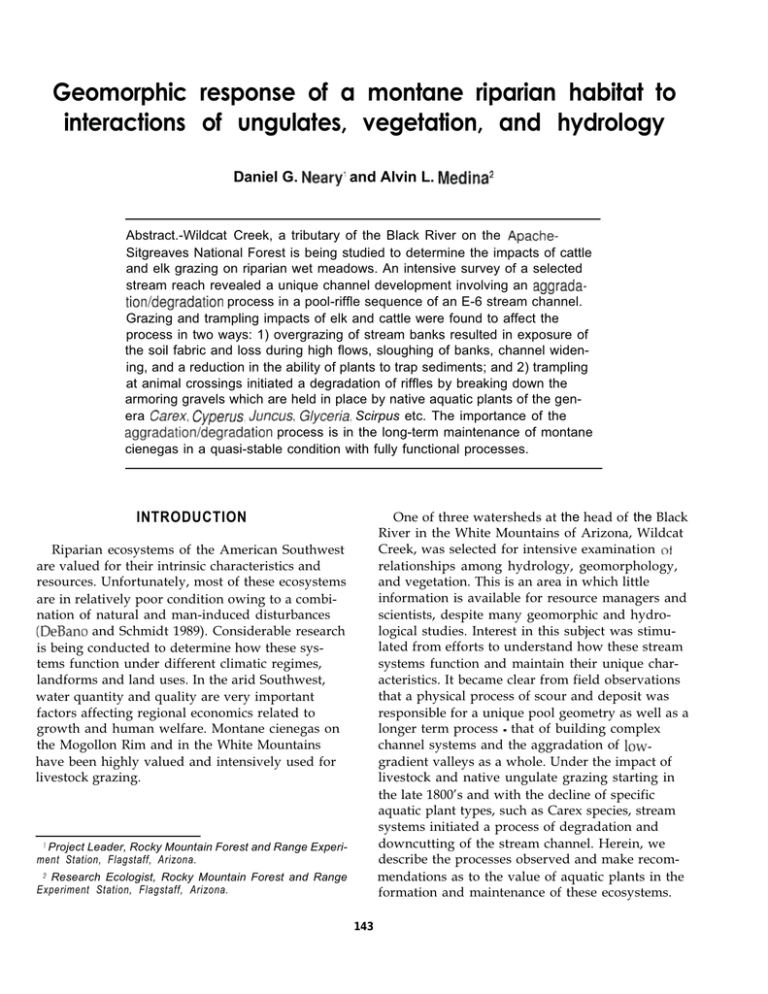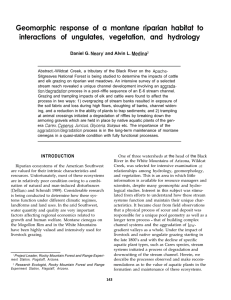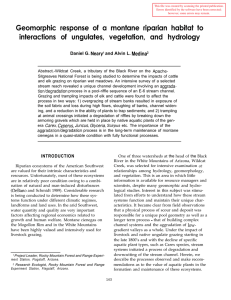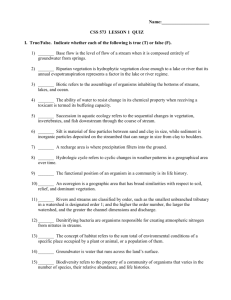Geomorphic response of a montane riparian habitat to
advertisement

Geomorphic response of a montane riparian habitat to interactions of ungulates, vegetation, and hydrology Daniel G. and Alvin L. Abstract.-Wildcat Creek, a tributary of the Black River on the Sitgreaves National Forest is being studied to determine the impacts of cattle and elk grazing on riparian wet meadows. An intensive survey of a selected stream reach revealed a unique channel development involving an process in a pool-riffle sequence of an E-6 stream channel. Grazing and trampling impacts of elk and cattle were found to affect the process in two ways: 1) overgrazing of stream banks resulted in exposure of the soil fabric and loss during high flows, sloughing of banks, channel widening, and a reduction in the ability of plants to trap sediments; and 2) trampling at animal crossings initiated a degradation of riffles by breaking down the armoring gravels which are held in place by native aquatic plants of the genScirpus etc. The importance of the era process is in the long-term maintenance of montane cienegas in a quasi-stable condition with fully functional processes. INTRODUCTION One of three watersheds at the head of the Black River in the White Mountains of Arizona, Wildcat Creek, was selected for intensive examination relationships among hydrology, geomorphology, and vegetation. This is an area in which little information is available for resource managers and scientists, despite many geomorphic and hydrological studies. Interest in this subject was stimulated from efforts to understand how these stream systems function and maintain their unique characteristics. It became clear from field observations that a physical process of scour and deposit was responsible for a unique pool geometry as well as a longer term process that of building complex channel systems and the aggradation of gradient valleys as a whole. Under the impact of livestock and native ungulate grazing starting in the late 1800’s and with the decline of specific aquatic plant types, such as Carex species, stream systems initiated a process of degradation and downcutting of the stream channel. Herein, we describe the processes observed and make recommendations as to the value of aquatic plants in the formation and maintenance of these ecosystems. Riparian ecosystems of the American Southwest are valued for their intrinsic characteristics and resources. Unfortunately, most of these ecosystems are in relatively poor condition owing to a combination of natural and man-induced disturbances and Schmidt 1989). Considerable research is being conducted to determine how these systems function under different climatic regimes, landforms and land uses. In the arid Southwest, water quantity and quality are very important factors affecting regional economics related to growth and human welfare. Montane cienegas on the Mogollon Rim and in the White Mountains have been highly valued and intensively used for livestock grazing. Project Leader, Rocky Mountain Forest and Range Experiment Station, Flagstaff, Arizona. Research Ecologist, Rocky Mountain Forest and Range Experiment Station, Flagstaff, Arizona. 143 METHODS March). Elk populations in the area are dense, and in combination with cattle grazing, affect the riparian vegetation and stream morphology. Study area Wildcat Creek is located in the east-central portion of Arizona known as the White Mountains. It is a headwaters stream of the West Fork of the Black River, a tributary of the Salt River. The geology is dominated by unglaciated basalts and andesite. Mean annual rainfall is about 74 cm with 2” C mean air temperature at an average elevation of 2556 m. The vegetation of the riparian meadows is dominated by a number of species of graminoids from the genera and Uplands are domion drier southerly slopes nated by on Typic Eutroboralfs soils and mixed-conifer species on northern, wetter exposures on Eutric Glossoboralfs soils (Hendricks Soils of these meadows are Typic Argiaquolls found in reaches, Argiaquic Cryoborolls and Argic et al. 1989). Cryaquolls in the wetter reaches They are alluvial and are saturated about 3-6 months of the year, primarily during the summer monsoons (July-September) and winter Surveys The Wildcat Creek drainage consists of steep upper and lower sections with a low gradient middle reach which contains a relatively narrow montane meadow. A planimetric survey of a 900 m portion of the mid-section of Wildcat Creek was conducted using a laser level. Longitudinal and valley profile measurements were taken to portray channel configurations. Additional measurements taken to characterize stream and channel geometry included: channel width, water depth, bank undercut dimensions, pool and riffle length, stream gradient, number and location of old channels, and streamside vegetation composition and cover. Data were analyzed to produce graphical depictions of site conditions. Photographs were taken to illustrate specific aspects of how vegetation influences streambank morphology. The soils of the site were examined and identified. PLAN PROFILE ACTIVE CHANNEL OLD CHANNELS Figure 1. Plan profile of the active and old channels in the Wildcat Creek riparian meadow, Apache-Sitgreaves National Forest. 144 average pool is 5.85 m long, with a minimum width of 86 cm and maximum width of 177 cm, a minimum pool depth of 19 cm and a maximum depth of 50 cm. Scour sections occur downstream of all riffle sections, and gravel deposits form on the inter-pool riffles (Figure 2). The scours occur runoff high flows, but mainly during summer monsoon flows can occasionally reach scour velocities. Over time these two major physical processes interact with aquatic vegetation components to result in the aggradation of alluvial materials in these meadows. Five distinct geomorphic actions occur as a result of the aggradation. Scouring action results in upstream migration and deepening of pools The deposited material in combination with the vegetation causes riffle areas to aggrade in three dimensions: longitudinal, horizontal and vertical. The aggradation process results in a deepening of the pool by elevation of the water surface and a change in channel direction during peak flows to other older channels of lower elevation This process is repeated in the new active channel. However, a change in the long term aggradation process can be reversed through the interaction of another biological component animals. RESULTS Geomorphic, vegetation, soils, and animal influence data are still being collected. This paper discusses some of the preliminary results. Geomorphology The soils of wet meadows are a product of the cumulative interactions of hydrological (scour and deposit) effects upon the stream channel and the floodplain, as well as the biological effects of vegetation and animals. These interactions can also manifest themselves to produce other soil types (Argiaquolls) typical of conditions such as old meadows that have had the water table lowered as described above. Valley dimensions in the study section ranged from 48 to 160 m wide. The stream channel was classified as an E-6 type (Rosgen 1994) with such characteristics as: 1.5% slope, sinuosity of 2.1, entrenchment ratio of 2.6, and width depth ratio of 9.6. Old channels are common in wider reaches with at least 2 in the narrow sections (Figure A longitudinal profile survey was conducted to determine the geometry of pools and riffles. The 0 13-l 7m RELATIVE Figure 2. Longitudinal view of typical scour and deposit zones of pool-riffle sequences in the Wildcat Creek riparian meadow, Apache-Sitgreaves National Forest. 145 Vegetation influences initiate a weakening of the soil fabric along the streambank, which leads to removal of fines by the current, and eventually initiates a down cutting of the riffle. Deterioration of the stream bank accelerates with continued ungulate use until large portions of streambank materials are sloughed into the channel. The lateral direction in which the channel is a function of the type of apt to change plant that inhabits the streambank. Streambanks with such fine rooted vegetation as Kentucky are much more susceptible bluegrass to erosion than banks with native species of 19961. Left unchecked, eventually the downcuttmg of the channel will result in: 1. Complete removal of riffle areas, The type of vegetation is most important in determining the direction and extent of channel aggradation or degradation. Native aquatic Cyperus., graminoids genera such as such as and are essential in maintaining stream bank integrity and capturing sediments (Medina 1996). Deposited material is quickly colonized by C. and other sedges. The strong, fibrous, rhizomatous roots of these species keep the substrates intact, while foliar parts trap additional materials, thereby accelerating the aggradation process (Figure Roots of native aquatic plant mm) and grow to species are fibrous, thick depths of 1.0-1.5 m. Those of introduced graminoids such as Kentucky bluegrass wheat grasses spp.), or orchard grass are shallow cm) and fragile (diameters mm). The trapping and armoring of the deposited substrates by native vegetation results in elevated, constricted riffles. These riffles are subsequently colonized by species in shallower sections, and species of and in deeper water. Bank heights are reduced as a result of the ponding action. Eventually, riffle areas of lower pools aggraded to such an extent (without being able to change channels) that they inundated the immediate upstream riffle and combined with the upper pool, thereby forming one long still water area. The depositional rate in the inundated riffle is apt to increase because of the reduced stream gradient. The continual aggradation of riffles results in subsequent changes in channel direction to an older channel of lower elevation. This channel will develop similar scour and fill morphology with time. Eventually riffles in this channel will also cause another change in channel direction. 2. A longer but shallower pool, 3. Lowering of the water table, and 4. Changes in streambank vegetation composition from aquatic to more mesic species. SUMMARY AND CONCLUSION The stream channel aggradation process produced by the interaction of native aquatic graminoids such as Cyperus, and with substrates is important to the long-term stability of montane cienegas. Hoof action of both native (elk) and introduced ungulates (cattle) can initiate breakdown of channel substrates and banks, leading to degradation of the riparian systems. Introduced mesic graminoids Agropyron, and are not able to such as contribute to the riparian system channel tion and are much less able to withstand the impact of ungulates due to the nature of their root systems. Understanding of the degradation processes is a prerequisite to successful management of these riparian systems for animal forage and fish habitat. Animal influences Ungulates can disrupt the aggradation process through the cumulative effects of herbivory and the tearing of the vegetation fabric with their hooves. When foliar parts are reduced, so is their capacity to trap and settle out suspended sediments which would otherwise get incorporated in the riffle. Hooves tear at the roots of the plant and LITERATURE CITED L.F. and L.J. Schmidt. 1989. Improving southwestern riparian areas through watershed management. USDA Forest Service, Rocky Mountain Forest and Range Experiment Station, 146 Medina, A.L. 1996. Native aquatic plants and ecological condition of Southwestern wetlands and riparian areas In USDA Forest Service, Rocky Mountain Forest and Range Experiment Station, General Technical Report, Fort Collins, CO, this issue. Rosgen, D.L. 1994. A classification of natural rivers. Catena General Technical Report RM-182, Fort Collins, co, 33 Hendricks, D.M. 1985. Arizona Soils. University of Arizona Press, Tucson, AZ, 244 p. Laing, L., N. Ambos, T. Subirge, C. McDonald, C. Nelson, and W. Robbie. 1989. Terrestrial ecosystem survey of the Apache-Sitgreaves National Forest. USDA Forest Service, Region 3,453 pp. 147









